
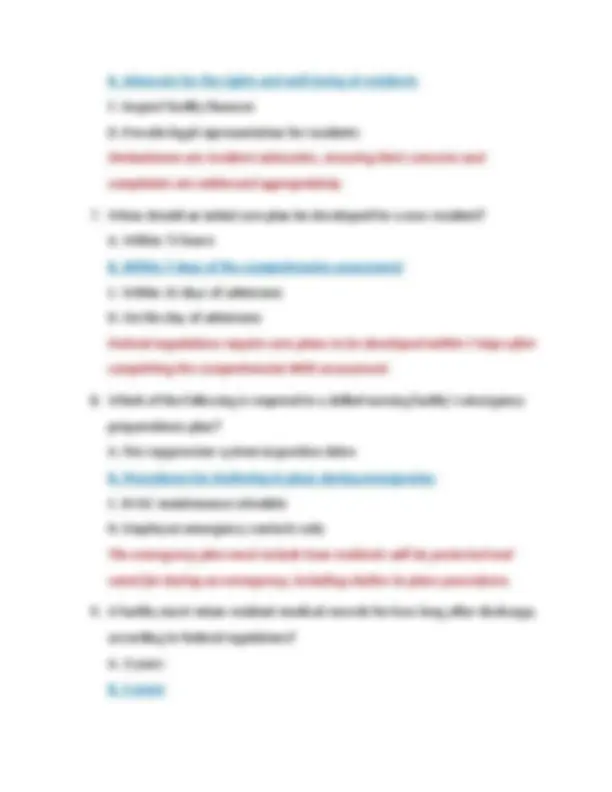
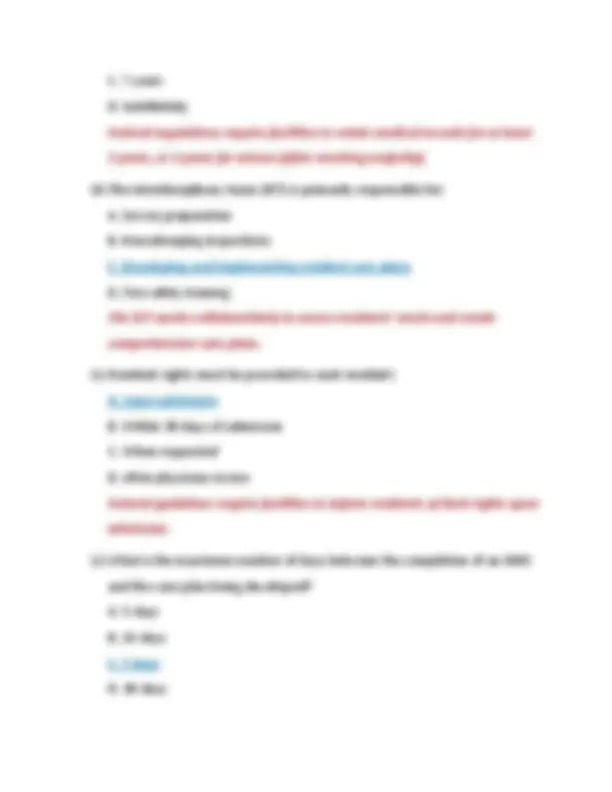
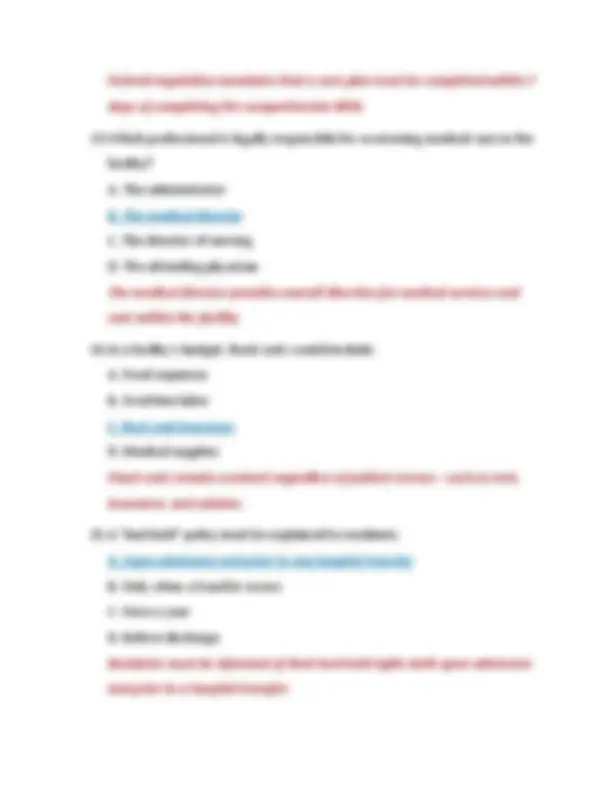
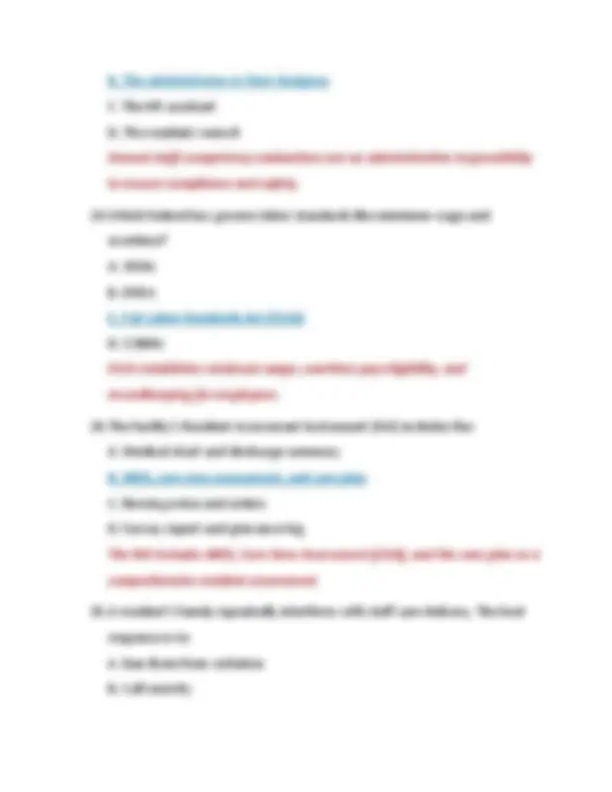
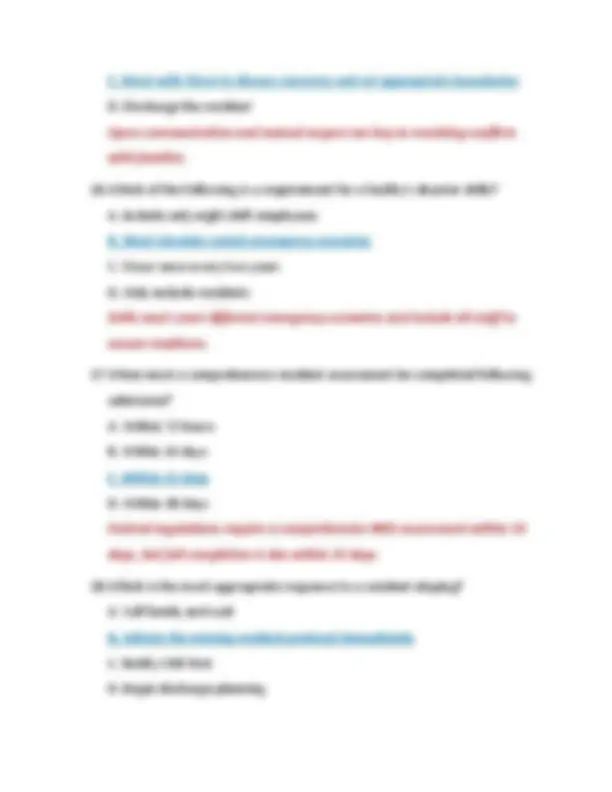
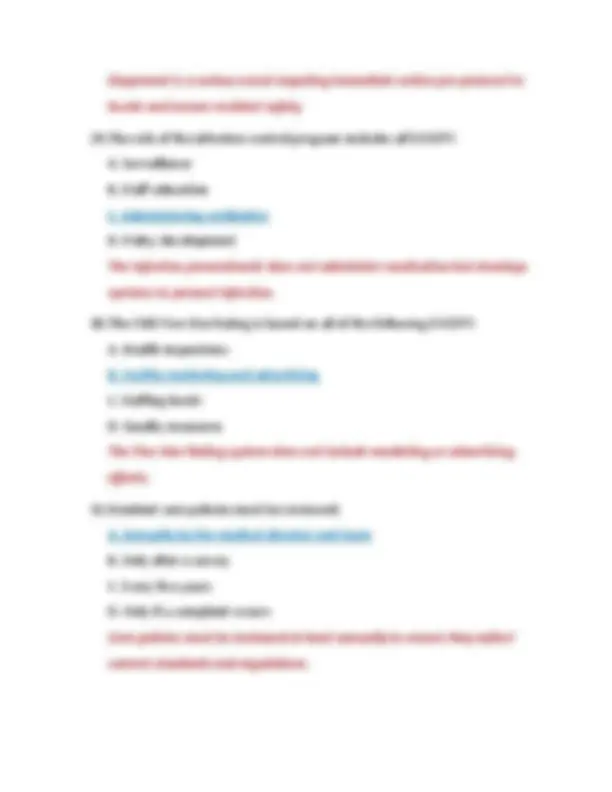

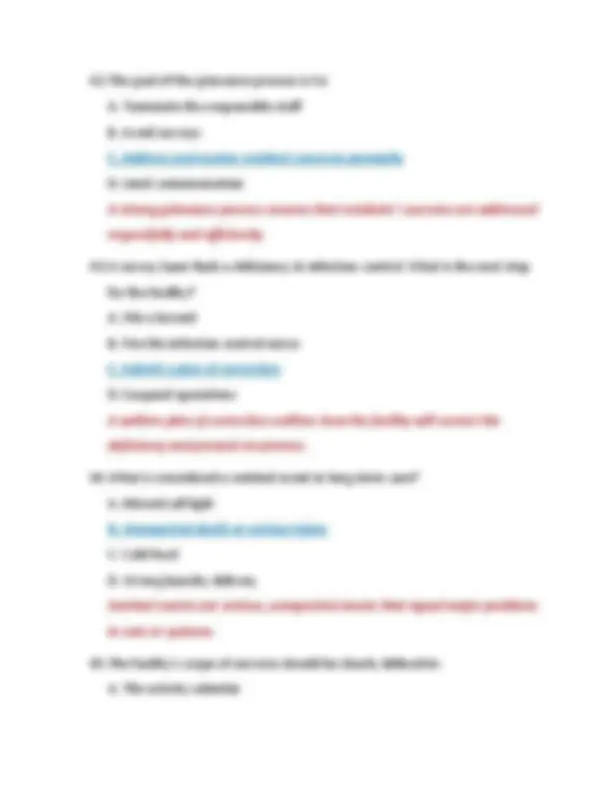
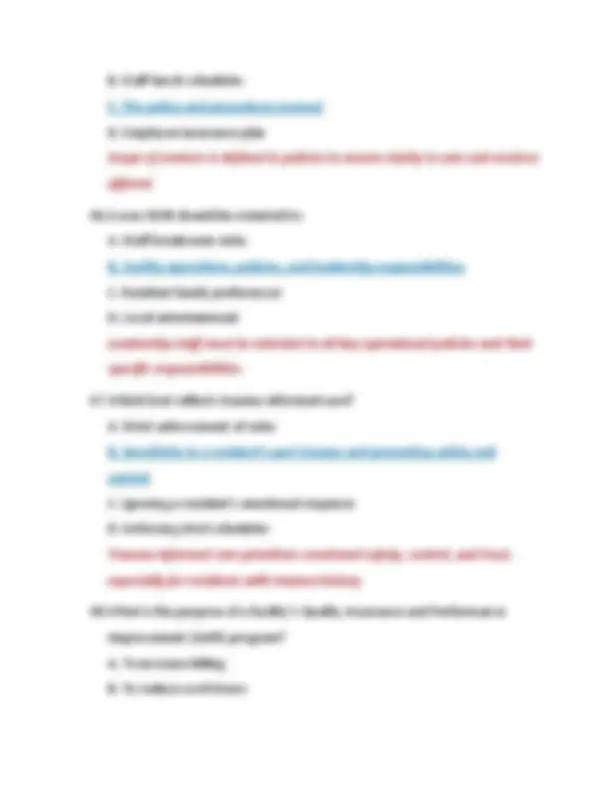


Study with the several resources on Docsity

Earn points by helping other students or get them with a premium plan


Prepare for your exams
Study with the several resources on Docsity

Earn points to download
Earn points by helping other students or get them with a premium plan
Community
Ask the community for help and clear up your study doubts
Discover the best universities in your country according to Docsity users
Free resources
Download our free guides on studying techniques, anxiety management strategies, and thesis advice from Docsity tutors
NAB NHA Line of Service Exam (Pennsylvania - 2022 version) Questions And Correct Answers (Verified Answers) Plus Rationales 2025 Q&A | Instant Downlo
Typology: Exams
1 / 16

This page cannot be seen from the preview
Don't miss anything!










C. 7 years D. Indefinitely Federal regulations require facilities to retain medical records for at least 5 years, or 3 years for minors (after reaching majority). 10.The interdisciplinary team (IDT) is primarily responsible for: A. Survey preparation B. Housekeeping inspections C. Developing and implementing resident care plans D. Fire safety training The IDT works collaboratively to assess residents’ needs and create comprehensive care plans. 11.Resident rights must be provided to each resident: A. Upon admission B. Within 30 days of admission C. When requested D. After physician review Federal guidelines require facilities to inform residents of their rights upon admission. 12.What is the maximum number of days between the completion of an MDS and the care plan being developed? A. 5 days B. 14 days C. 7 days D. 30 days
Federal regulation mandates that a care plan must be completed within 7 days of completing the comprehensive MDS. 13.Which professional is legally responsible for overseeing medical care in the facility? A. The administrator B. The medical director C. The director of nursing D. The attending physician The medical director provides overall direction for medical services and care within the facility. 14.In a facility’s budget, fixed costs would include: A. Food expenses B. Overtime labor C. Rent and insurance D. Medical supplies Fixed costs remain constant regardless of patient census—such as rent, insurance, and salaries. 15.A "bed hold" policy must be explained to residents: A. Upon admission and prior to any hospital transfer B. Only when a transfer occurs C. Once a year D. Before discharge Residents must be informed of their bed-hold rights both upon admission and prior to a hospital transfer.
A. Hand hygiene B. Wearing gowns C. Isolating residents D. Using disposable utensils Proper hand hygiene is the most effective method for preventing the spread of infections. 20.The main reason for documenting incidents is to: A. Justify punishment B. Identify trends and prevent recurrence C. Keep legal records D. Meet staffing quotas Incident reports help identify systemic issues and guide prevention strategies. 21.Which of the following best describes a facility’s governing body? A. The administrator and director of nursing B. CMS and the Department of Health C. The legally responsible entity for overall facility operation and policy setting D. A group of licensed physicians The governing body has legal authority and responsibility for strategic direction, policies, and overall management of the facility. 22.Who is responsible for ensuring staff competencies are evaluated annually? A. The medical director
B. The administrator or their designee C. The HR assistant D. The resident council Annual staff competency evaluations are an administrative responsibility to ensure compliance and safety. 23.Which federal law governs labor standards like minimum wage and overtime? A. OSHA B. ERISA C. Fair Labor Standards Act (FLSA) D. COBRA FLSA establishes minimum wage, overtime pay eligibility, and recordkeeping for employees. 24.The facility's Resident Assessment Instrument (RAI) includes the: A. Medical chart and discharge summary B. MDS, care area assessment, and care plan C. Nursing notes and orders D. Survey report and grievance log The RAI includes MDS, Care Area Assessment (CAA), and the care plan as a comprehensive resident assessment. 25.A resident’s family repeatedly interferes with staff care delivery. The best response is to: A. Ban them from visitation B. Call security
Elopement is a serious event requiring immediate action per protocol to locate and ensure resident safety. 29.The role of the infection control program includes all EXCEPT: A. Surveillance B. Staff education C. Administering antibiotics D. Policy development The infection preventionist does not administer medication but develops systems to prevent infection. 30.The CMS Five-Star Rating is based on all of the following EXCEPT: A. Health inspections B. Facility marketing and advertising C. Staffing levels D. Quality measures The Five-Star Rating system does not include marketing or advertising efforts. 31.Resident care policies must be reviewed: A. Annually by the medical director and team B. Only after a survey C. Every five years D. Only if a complaint occurs Care policies must be reviewed at least annually to ensure they reflect current standards and regulations.
32.The first step in developing the operating budget is to: A. Set staffing ratios B. Survey resident satisfaction C. Project revenues and expenses D. Hire an accountant Projecting revenues and expenses provides the foundation for building an accurate budget. 33.What is a common indicator used to measure staff turnover? A. Daily schedule changes B. Number of staff separations divided by average staff count annually C. Number of call-offs D. Resident complaints Turnover rate is calculated by dividing the number of separations by the average staff number over a set period. 34.Which is NOT a function of the safety committee? A. Review incident reports B. Handle residents’ legal claims C. Analyze accident trends D. Recommend corrective actions Legal claims are handled by risk/legal departments, not safety committees. 35.The care area assessment (CAA) is used to: A. Identify triggered areas for individualized care planning B. Schedule medical appointments
D. Inspect fire systems HR ensures that staff are hired, trained, and managed in accordance with facility policy and regulations. 39.When must a facility complete a baseline care plan after admission? A. 14 days B. 10 days C. Within 48 hours of admission D. At discharge Baseline care plans must be developed within 48 hours to guide immediate resident care. 40.Which of the following is a key indicator of resident quality of life? A. Autonomy and dignity B. Medication errors C. Nurse overtime D. Building aesthetics Autonomy and dignity are vital components of a resident’s quality of life and are protected by regulations. 41.A facility should report significant medication errors: A. Only to the family B. Quarterly C. Immediately to the physician and per state guidelines D. After a full investigation Significant medication errors must be reported promptly to ensure resident safety and regulatory compliance.
42.The goal of the grievance process is to: A. Terminate the responsible staff B. Avoid surveys C. Address and resolve resident concerns promptly D. Limit communication A strong grievance process ensures that residents’ concerns are addressed respectfully and efficiently. 43.A survey team finds a deficiency in infection control. What is the next step for the facility? A. File a lawsuit B. Fire the infection control nurse C. Submit a plan of correction D. Suspend operations A written plan of correction outlines how the facility will correct the deficiency and prevent recurrence. 44.What is considered a sentinel event in long-term care? A. Missed call light B. Unexpected death or serious injury C. Cold food D. Wrong laundry delivery Sentinel events are serious, unexpected events that signal major problems in care or systems. 45.The facility’s scope of services should be clearly defined in: A. The activity calendar
C. To monitor and improve care processes and outcomes D. To track resident visitation QAPI is a comprehensive approach to identifying problems and improving care systems and services. 49.A resident expresses a desire to return home. What should staff do first? A. Discharge them immediately B. Tell them it's not possible C. Assess their ability and develop a discharge plan with the interdisciplinary team D. Ignore the request Staff must respect resident autonomy while assessing safety and planning a viable discharge. 50.Who enforces federal regulations in nursing facilities? A. Local law enforcement B. Centers for Medicare & Medicaid Services (CMS) C. The fire marshal D. Resident council CMS enforces federal compliance through surveys and penalties for deficiencies.